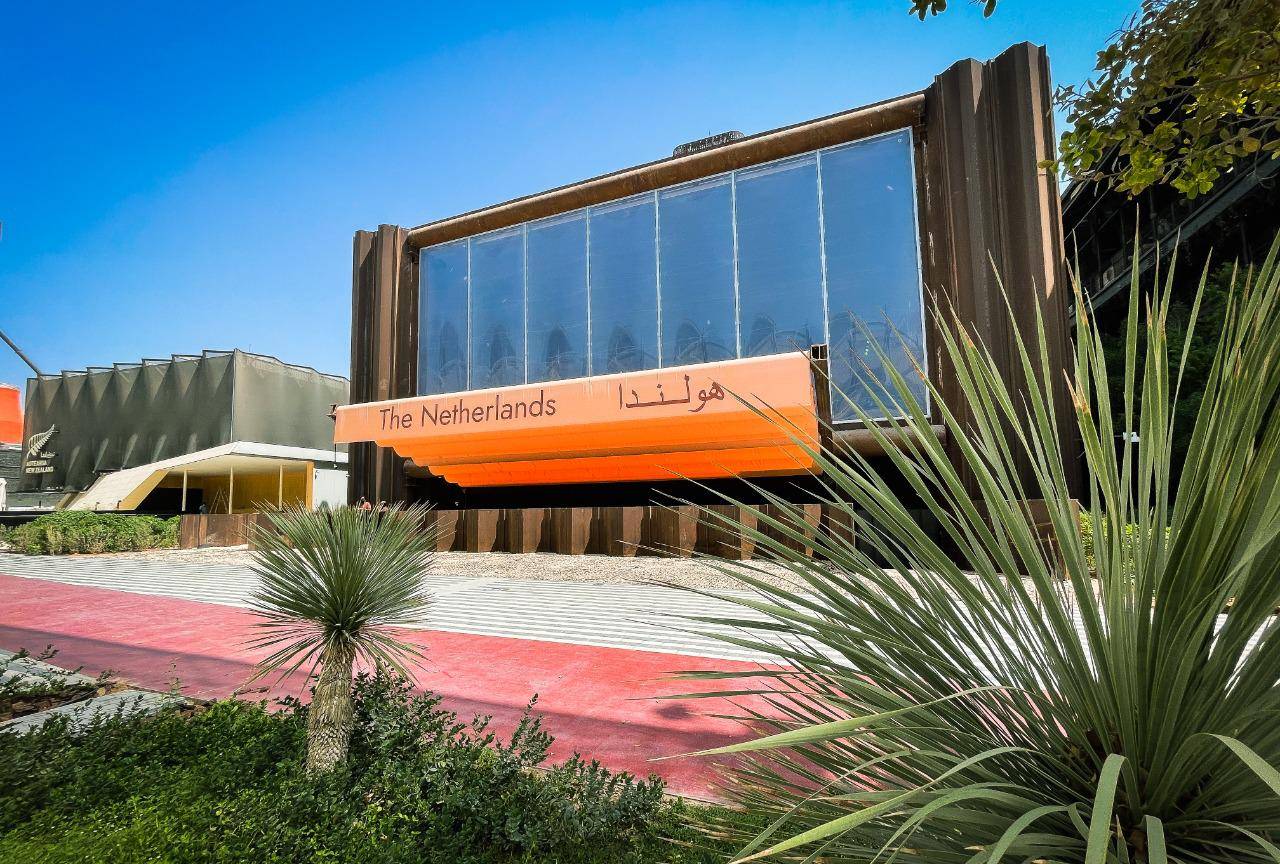[ad_1]
The pavilion designed by Rotterdam’s V8 Architects abandoned typical concrete buildings in favor of biomes.
Have you ever thought about living in a world with zero carbon emissions, zero waste of natural resources, zero food shortages and global warming? This is just your imagination? Walking into the Dutch Pavilion located in the sustainable development zone, visitors will enter a recyclable miniature world-a biome with its own climate, because it creates its own water, energy and food.
From the floor, you stand on the curtains hanging over the hall, and the water produced by the vertical farm every day emits the fragrance you can smell. The pavilion shows how to implement the recycling management of natural resources to save our planet.
Carel Richter, Consul General and Curator of the Kingdom of the Netherlands in Dubai, said that what you see in the museum is a project that started three years ago. Its vision is to combine water, energy and food and raise awareness about the scarcity of natural resources. Related global challenges.
“The pavilion shows how to combine water, energy and food with a new way of thinking. This thinking helps us find solutions for future challenges, which are due to population growth, extreme water scarcity, food scarcity, and energy scarcity. If you are efficient, you can combine them in a sustainable way, create cycles, and find solutions for future challenges,” the diplomat said.
Vertical farm that produces its own energy, water and food
The pavilion designed by Rotterdam’s V8 Architects abandoned typical concrete buildings in favor of biomes. At the center of the pavilion is a giant green cone measuring 19 meters, covered with about 3,500 edible plants, such as basil, cress and other sprouted vegetables planted around the cone in the form of a ring. The farm is irrigated with water collected from the air using Dutch technology, and solar energy is irradiated through colorful low-tech plastic solar panels on the roof. The “Rainmaker” technology jointly developed by SunGlacier Technologies and Dutch artist Ap Verheggen uses solar energy to extract 800 liters of water from the desert air every day. At the same time, the sunlight passing through the panels helps the plants to photosynthesize and paint the pavilion with different tones.
Michiel Raaphorst, the director of the pavilion’s architect, said that this scalable technology can solve the water shortage in arid and dry climates like the UAE.
“The Dutch are good at agriculture. We use a very smart system. We don’t spend liters of water on irrigation.”
He said they used a “drop by drop” method to water each plant based on altitude, humidity and temperature.
Bioclimate in the cone
The vertical cone where plants are grown outside is a mushroom nursery. To get there, visitors must walk a winding path with a rusty slope extending four meters down the ground, and the weather immediately cools down.
The walk itself is a multi-sensory experience, because the bikes from the Netherlands roar past, and the sound of cows moo fills the air. When you enter a dimly lit space, visitors will be handed an umbrella, which will provide a visual experience of close contact between nature and people. When animated raindrops fall on the umbrella, the aroma of mushrooms will fill your nose. At the end of the performance, water enters the basin in the middle of the cone through the central chimney.
“This is part of the collected water. Humidity and lack of sunlight make it the perfect environment for growing mushrooms,” Raaphorst said.
“Textile” canopy
The exterior of the pavilion is a textile canopy made of bio-based materials. In addition to being sustainable, the canopy designed by Amsterdam-based BuroBelen can also prevent skin cancer caused by solar radiation and at the same time allow the body to produce vitamin D.
Corn curtain
In order to keep the carbon footprint of the pavilion to a minimum, many of the materials used are locally sourced, reusable and biodegradable. For example, the 26-meter-wide and 12-meter-long curtains designed by BuroBelen use natural substitutes for plastic derived from corn starch.
Mushroom floor
The floor and sound-proof wall panels of the business rest area are designed with a new bio-based building material, which is made of a mycelial composite core (fungus extracted from mushroom roots), from the Italian interior design company Mogu. The rest of the floor has a temporary floor made of stone and iron grids, which can also be reused and reused for future construction.
Steel plate and steel pipe
The rusty steel plates and pipes that make up the main structure of the pavilion are purchased locally and will be returned after the Expo ends, emphasizing the recyclability of building materials.
Perfume made from grass and hay
Inside the cone, visitors will smell a unique perfume made from grass, hay and cow dung. The architect said that this is a complicated process, but the final product is a subtle smell that represents the Netherlands. The perfume can be seen passing through the glass device on the wall and then collected in a jar with a lid.
Reverse clock
The tour of the pavilion ended with a thought-provoking but clear message that time is running out for us to take meaningful actions to save the planet. The hour clock designed by Atelier Van Lieshout doubles as an alarm clock for humans, reminding humans that “the wheel of time will be ruined or greeted with a new dawn.”
“We are already late. But if we are taking any action to mitigate climate change and save the planet, it is now,” LaFoster summed up the message that the pavilion hopes to convey through the 2020 World Expo.
anjana@khaleejtimes.com
[ad_2]
Source link
